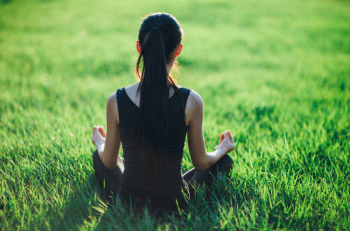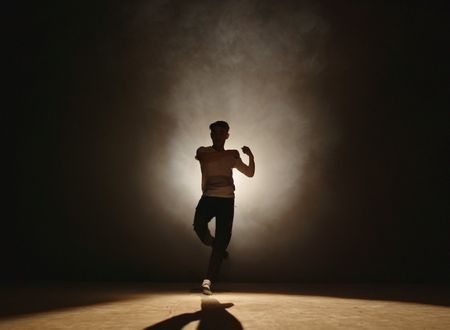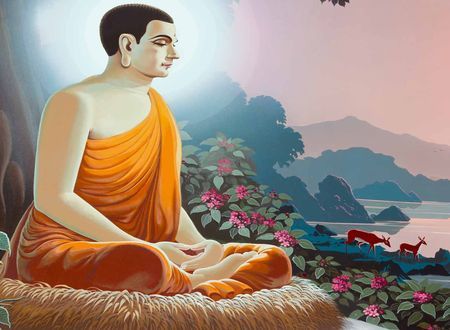In the last post I talked about meditation of two types.
Today, I am going to expand on the practice of concentrative meditation.
Concentrative meditation is the art of staying on one thought. It is specifically different to contemplative meditation in the sense that no intellectual examination is performed while practicing this meditation. It is predominantly designed to help you settle your mind and attain stillness of the body.
Concentrative Meditation sharpens your concentration and builds your brain muscle.
In a way, concentrative meditation is the preliminary practice of meditation. As you continue to practice, you will experience an inexplicable calmness, bliss will engulf you, a definitive quietude will dawn on you.
Krishna says to Arjuna:
yatroparamate cittam nirud’dham yogasevaya।
yatra caivatmanatmanam pashyannatmani tushyati।।(Bhagavad Gita, 6.20)
With the constant practice of yoga, in that state of perfect stillness of the mind, the yogi experiences his true nature. With his supremely purified self, attained as a result of meditation, he remains firmly established in his primordial state.
Further, in the same chapter, he instructs:
shanaih shanairuparamedbudhya dhrtigrhitaya।
atmasanstham manah krtva na kincidapi cintayet।। (Bhagavad Gita, 6.25)
Steadily, with practice, such a yogin should meditate with patience and resolve, constantly bringing his wandering mind back to the Divine. He should meditate on the Divine, the Supreme, and do nothing else during his practice.
Various Buddhist texts on meditation share the same view. Notably, Madhyamaka Hridya states:
If one is overcome with distraction, one should retreat and regard it as a sign of diversion.
And, Prajñāpāramitā documents that firm concentration pacifies craving for sensory pleasures.
Stillness of the body and mind comes with great practice. Let me get to the actual practice; as follows:
1. Sit in a comfortable posture, preferably crossed legged.
2. Keep your back and head straight. Neck, slightly bent, only just.
3. Abandon all body movements.
4. Yoke your focus on any object.
5. Maintain great mindfulness.
This is maintaining posture in meditation. Each time your mind wanders off, bring it back to the point of focus. Over time you will develop razor-sharp awareness; so much so, that you will become aware of each emerging thought before it turns into a distraction.
Correct posture plays a significant part in right meditation. I will cover the importance and benefits of correct posture when we get to Physical Transformation.
For now, just know that a steady, comfortable, and correct posture helps you gain control over the five primary energies and the act of concentrative meditation stills the five secondary energies. In the next post, I will briefly cover the ten vital energies. Manipulation and channelization of these energies will help you maintain one posture for as long as you want.
It is particularly important to note that during concentrative meditation, you must stay away from all intellectual examination, contemplation, and cogitation.
For example, let us say, you are meditating on a form. And you have, in front of you, an idol of Krishna you are meditating on. Do not start examining the characteristics of the idol or start thinking about Krishna, his pastimes, his life, and so forth. Just keep your attention focused on his form. In the initial stages, if you start contemplating before attaining one-pointed concentration, your mind will wander off and you may not even realize it.
Do not accept, reject, examine, follow, engage in, or pursue your thoughts. Do not act or react. Just gently maintain your concentration. You may want to refer to the post on one-pointed concentration to know the four types of objects for concentration. Maintain short but crisp and lucid sessions of meditation.
An untamed mind cannot stay on a thought for any longer than three seconds.
I would recommend that rather than doing one session of forty-five minutes, do three sessions of fifteen minutes. They will bring about much greater benefits. Over time, as you get better, you can gradually increase the duration.
I would also like to tell you that there is no joy in concentrative meditation, in the actual practice. But once you start to experience a quiescent mind, you will almost be addicted to meditation.
Peace.
Swami
Editorial Note
Concentrative meditation, though the hardest form of meditation, stills the mind like no other, and makes it powerful.
Course
Art of Meditation
Free yourself from suffering and live life to the fullest. Learn the yogic technique of meditation in 4 days (and master it over a lifetime)
These FAQs go into more detail about concentrative meditation, its importance and some of the hurdles to overcome for correct meditation.
How can I improve my concentrative meditation?
In simple words, concentration is the practice of fixing your mind on one single object. How to improve concentration?

The term is ekagrata, single-mindedness. If I split this word for better understanding, it is comprised of Ek, one, and Agra, proceed. It means to proceed with oneness, with focus, with synchronicity, in a channelized fashion. Just before you enter into the meditative state, a certain uninterrupted stillness is required in your ekagrata for a reasonable period.
There are four ways to build ekagrata which naturally improve your concentrative meditation. Read more here.
Why is concentration so important in meditation?
To become a good meditator requires great concentration, and to become a great meditator requires supreme concentration. Concentration, especially one-pointed concentration, comes with practice. The more you practice, the crisper your concentration.

If you want to experience that inner bliss through the path of meditation, no matter how much you may dislike having to sit and work towards building one-pointed concentration, the fact is you will have to do it. Concentrative meditation is key.
If you can hold your concentration for as long as you want, you are on the verge of discovering meditation in its truest sense. Here are two anecdotes, about Arjuna, the warrior prince, that define how concentration is also an act of simplification.
How do I overcome restlessness during meditation?
As you sit down to meditate, after a few seconds, stray thoughts from all directions start to hit you. As you continue to try and build your concentration, you experience a certain degree of restlessness. It almost feels as if the more you try to stay away from your thoughts, the stronger they seem to come at you, making you restless. It is normal, whether you are practicing concentrative meditation or any other type of meditation.
When you experience restlessness, and, as it builds up during your meditation, you may feel the uncontrollable urge to move, shift, talk, and or even end your session. Do not be impatient when restlessness emerges. The cause is natural, and the remedy (here), simple.
A GOOD STORY
There were four members in a household. Everybody, Somebody, Anybody and Nobody. A bill was overdue. Everybody thought Somebody would do it. Anybody could have done it but Nobody did it.
Don't leave empty-handed, consider contributing.It's a good thing to do today.









Comments & Discussion
15 COMMENTS
Please login to read members' comments and participate in the discussion.